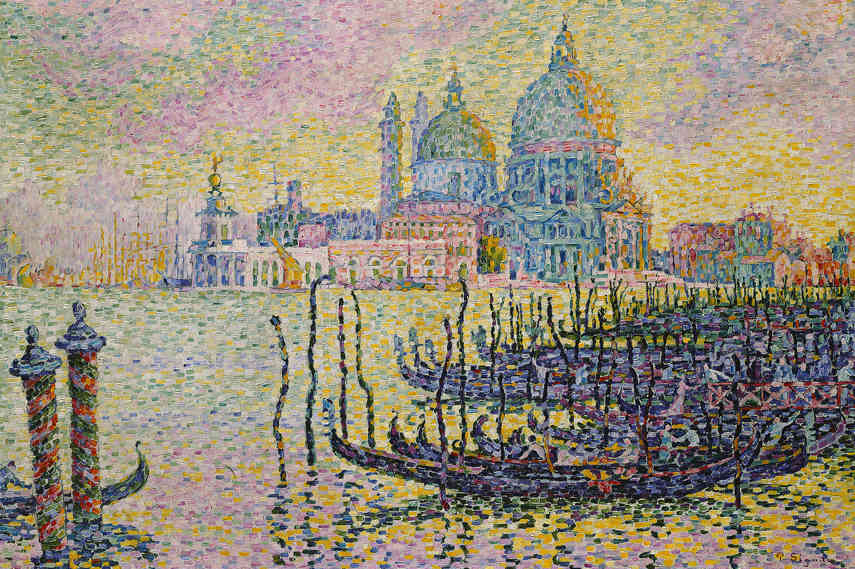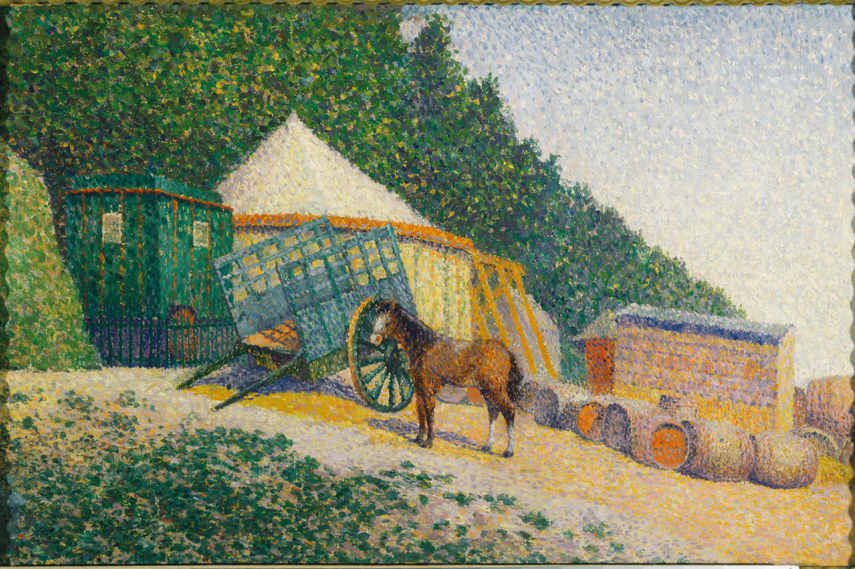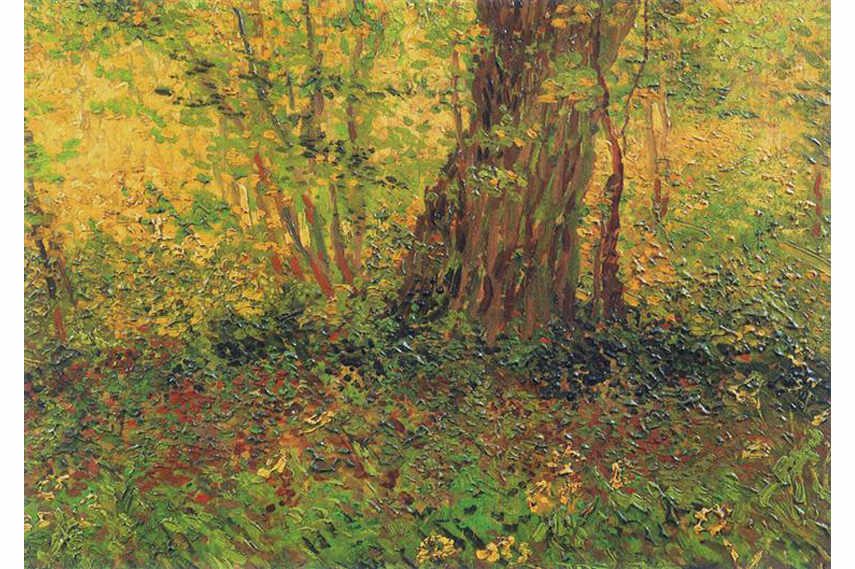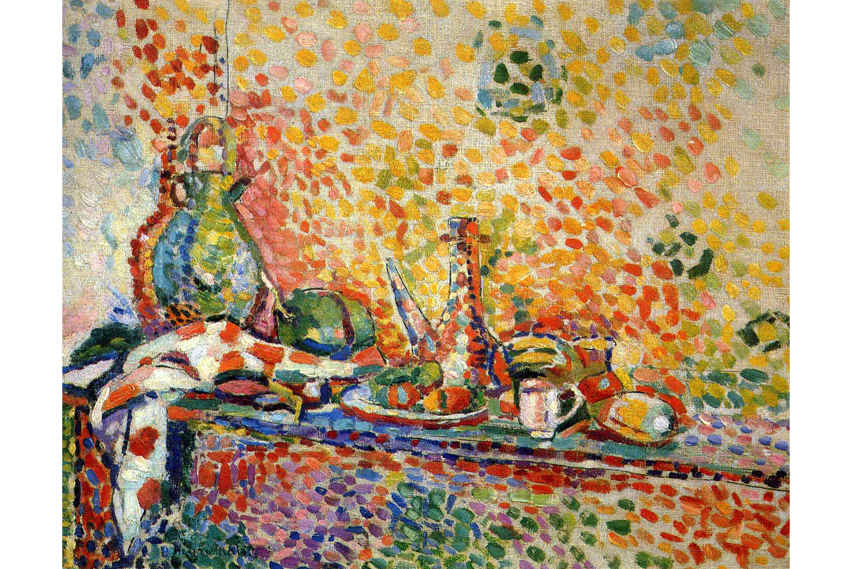What Is the Name for the Art Movement That Criticizes Other Art
Pointillism can be described relatively but – it'due south an art movement named after a technique in which small dots of color are applied to canvas in order to grade an image. Today, the term dotted art is also in colloquial use, and information technology describes the application of small dots of unlike colour painted on canvas. As a historical art movement, Pointillism has a very detail implication, but nowadays it's usually described every bit a special technique that has been used by a number of different artists, all of them creating in various contexts when information technology comes to art movements. The nascence of Pointillism dates back to the Belle Epoque in Paris and the time of the Impressionist art. It is generally related to the French painter Georges Seurat, whose masterpiece Dominicus on the Island of La Grande Jatte is widely praised as the most famous of the Pointillism paintings.

The Emergence of Pointillism
Georges Seurat and Paul Signac'southward practice and paintings led to the emergence of Pointillism, ordinarily associated with the twelvemonth 1886. Both artists used this mode earlier, but it was art critics who coined the term in order to draw their boggling innovative approach to canvas and paint. In the very outset (the late 19th Century), the critique had a rather mocking mental attitude towards the technique used by Seurat and Signac – they were criticizing their practice, assertive that the term "Pointillism" would have a pejorative connotation. All the same, history proved these abrupt-penned pedantists incorrect, while Pointillism entered the books as one of the most progressive art movements of the era. Introducing a completely new perception in the field of color studies, Pointillism has had a huge influence on diverse art movements, spanning from the end of the 19th century and the avant-garde throughout the 20th.

Definition of the Style and Technique
Pointillism describes a technique in which hundreds of small dots or dashes of pure color are applied to the canvas, or some other surface, in order to create maximum luminosity. This manner of creating fine art relies on the ability of the eye and listen of the viewer to blend the color spots into a range of tones. This technique is in sharp contrast to the traditional methods of blending pigments on a palette. It'due south more similar to the four-color CMYK press process used by some colour printers (Cyan (blueish), Magenta (ruby), Yellowish, and Central (black)). If the composition is viewed from a certain distance, (supposedly 3 times the diagonal measurement) the dots of colour give a richer and more subtle effect than can exist achieved by conventional techniques. The field of study-thing is non as important as dots in Pointillist compositions. It'southward all about the dots and the image they create. Finally, the majority of Pointillism paintings have been washed in oil paints. There are exceptions to the rule only they are scarcescarcely to be establish.

What is the Divergence between Dotted Art and Pointillism?
Terms dotted art and pointillism refer to the same thing. The only departure is that Pointillism is used more among art historians, art lovers and collectors, while the dotted art among a wider public. Dotted art is pop among non-professional artists and many other artistic practices use "dotted painting". For case, Aboriginal art is, amid many other things, known for its dotted paintings. Apart from these contextualizing differences, there isn't much more to be said nigh differences between dotted art and Pointillism.

Pointillism and Divisionism
Pointillism is sometimes wrongly associated with Divisionism (sometimes called chromoluminarism). Divisionists besides used a similar fashion of patterns to form images, only the last issue of their practise was unlike. Both techniques emerged at the same time, and both of them were considered to be part of Post-Impressionism.
Divisionism emerged thanks to the scientific theories and rules of color. For example, the famous Charles Blanc's colour wheel influenced the practice of Divisionists. Notwithstanding, while divisionism was preoccupied with colors, and their divisions, Pointillism was founded on possibilities of creating blueprint art, shapes and perspectives out of dots. When pointillist piece of art was created, not much attention was given to the separation of colors. It could be argued that the confusion arose due to the fact that the same artists were "responsible" for the emergence of Pointillism besides as Divisionism (Seurat, Signac, and even van Gogh). Maybe the biggest difference between the two styles may be noticed when inspecting the "final product". Divisionists used larger cube-similar brushstrokes, while Pointillist compositions are obviously characterized by multicolor dots.

Pointillism and Other Fine art Movements
The biggest names who used the pointillist style of painting were in function Post Impressionist artsts. Postal service-Impressionism emerged in the mid-1880s, and by many is regarded as the offset true advanced movement in painting. One of the main aims of the movement was to contain the latest explanation of optic and colour perceptions. Past using dots or larger cube-similar brushstrokes, Postal service-Impressionists actually practiced the latest discoveries of the theory of colors and perception. Still, the Pointillist approach isn't exclusively related to Mail-Impressionism. Information technology as well had a big impact on other styles equally well, including Cubism, and even Pop Art.
Finally, today there are many of contemporary artists who nonetheless use this extraordinary technique in their art. Observing the current trends in digital inventiveness, one tin can certainly pose a question: Is at that place not a connectedness between Pointillism and pixels in computer art? Isn't the pixel fine art a sort of dotted art as well? The logic is the aforementioned, however, the style and context are completely different.
Pointillism in Music
Pointillism in Music
The term "Pointillism" as well refers to a music genre that emerged at the end of the 1940s. It's besides sometimes chosen Punctualism and point music. Stockhausen defines this type of music as music that consists of separately formed particles — however, complexly these may be equanimous, every bit opposed to linear, or group-formed, or mass-formed music. This term firstly emerged in the early 1920s. The French word pointillisme, evoking Seurat's painting technique, had been applied to music in this reverse sense of a "mosaic-similar method of construction, an infinite accumulation of minor and insignificant inorganic details", with reference to Arnold Schoenberg's operas, Erwartung and Die glückliche Hand. But, the nearly notable representatives of this music genre were creating in the 1940s and 1950s. They are Anton Webern, Olivier Messiaen, Pierre Boulez, Karel Goeyvaerts, and many others. Of grade, at that place aren't direct relations between Pointillism in visual arts and Pointillism in music. However, they are based on the same contemplative principles.

The About Influential Pointillism Artists
Beside Georges Seurat and Paul Signac, who conceived Pointillism as an art technique and conducted the group of artists who adopted that painting mode, later, many other artists were influenced by Seurat and Signac, claiming to exist Pointillists themselves. Generally, those were French, Italian and Belgian artists, every bit they were the ones who contributed the nigh to the evolution of Expressionism in Europe. Alongside them, some Dutch artists contributed to the acknowledgment of the technique. Vincent van Gogh was one of them, as he occasionally painted using what was known equally the Pointillism technique. But, it wouldn't have happened, if his brother Theo van Gogh didn't innovate him to Camille Pissarro in the first place. Side past side with Pissaro, at that place were artists like Albert Dubois-Pillet, Henri-Edmond Cantankerous, Charles Angrand, and many others, who took the leading roles in the Pointillism development throughout the second one-half of the 19th century.

Camille Pissarro - Depicting the Ordinary Life
Camille Pissarro was one of the artists that stood out within the use of Pointillism as a painting technique. But how did he get to that point? By the 1880s, Pissarro had already begun to explore new themes and methods in order to interruption out of the ordinary painting at the time. So, he turned his back to Impressionism and went all the mode dorsum to his early topics – portraying a common man, with his paintings depicting people at home, or at work, simply in rather realistic settings. It was the time when Pissarro met Georges Seurat and Paul Signac, who already had used small patches of colors to create the illusion of blended colors and shading when viewed from a distance. Pissarro embraced the new technique referred to equally Pointillism and spent years from 1885 to 1888 practicing and implementing it in his work. Pissarro somewhen became the only artist who went from Impressionism to Post-Impressionism. But afterward, he turned away from Post-Impressionism, challenge that its arrangement was too artificial.

Albert Dubois-Pillet – Armed services Officer and a Self-Taught Painter
Albert Dubois was a French military officer who fought in the Franco-Prussian war. But, there was another part of is personality, which was in directly opposition to militarism. He wanted to be a painter, so he taught the techniques for himself, and eventually closely aligned with Mail-Impressionist as an apprentice painter. He was certainly talented, and various Salons accustomed his work for exhibitions during 1877. Dubois was a friend of Georges Seurat, and he was the ane who founded the Société des Artistes Indépendants in 1884 and also helped to write its statute. In the concurrently, Albert Dubois became one of the first artists to adopt Pointillism. Only, his military service conflicted with his artistic expressions, so he had to hide. In order to cover-up his artistic practise, he started signing his fine art pieces with his last name, Dubois, with the addition of his mother's maiden name – Pillet. So, he remained known as Albert Dubois-Pillet in the creative circles.

Charles Angrand – Important Fellow member of Parisian Advanced
Charles Angrand was a French artist who gained acknowledgment for his paintings and drawings, later deemed Post-Impressionistic. He was an important member of the Parisian avant-garde art scene in the tardily 1880s and early 1890s. Influenced by Claude Monet and Camille Pissarro, Charles Angrand as well interacted with artists like Seurat and Signac through the mid-1880s, which led his fashion towards Post-Impressionism. Although, Angrand's implementation of Pointillist techniques differed from others'. His palette was more muted than bright contrast colors of Seurat and Signac. Angrand more often than not used dots of various colors to raise shadows, merely he was avoiding the fierce coloration found in many other pointillism paintings. He painted in monochrome conté crayon technique, which could exist seen in his self-portraits, for instance. "His drawings are masterpieces. Information technology would be impossible to imagine a better use of white and black. These are the most beautiful drawings, poems of light, of fine composition and execution", Paul Signac noted for Angrand'due south artworks.

Vincent van Gogh – Finding and Expressing Lite
Even Vincent van Gogh painted occasionally in a Pointillist mode. Lucien Pissarro, son of Camille Pissarro, believed it was due to his father'south straight influence on Vincent van Gogh and his art. Reportedly, it was his brother and art dealer Theo van Gogh who kickoff came to an idea to connect Vincent with Camille Pissaro. It happened in 1884 when Pissarro accepted to take in the celebrated painter as a lodger in his home. Lucien Pissarro wrote that his father was impressed by Van Gogh'due south piece of work and had foreseen the power of this artist, who was 23 years younger than himself. Camille's son also noted that his begetter did explicate different ways of finding and expressing light and color to their young protege, which he later used in his paintings. Largely influenced past Pointillism at the time, Pissarro also transferred some of that technique to van Gogh, who later occasionally painted some of his paintings using the dotted art.

Henri-Edmond Cross – A Divisionism Portraiture
One of the most influential artists throughout the second phase of Post-Impressionism was a French painter and printmaker Henri-Edmond Cross. He is most acclaimed as a principal of Post-Impressionism, with an instrumental influence in the development of Fauvism . In 1884, Cross was a co-founder of the Société des Artistes Indépendants, which was the fourth dimension when he met many similar-minded artists, including Georges Seurat, Albert Dubois-Pillet, and Charles Angrand. Despite the close human relationship with them, Henri-Edmond Cross didn't prefer their style for many years. It was in 1891 when he finally began painting in the mode of the group and the same year he exhibited his first art piece made with Pointillist technique. Information technology was a divisionist portrait of Madame Hector France, who became Cross'due south married woman in 1893. "The moving picture is softly charged with a granular, atmospheric glow", Robert Rosenblum wrote virtually this Cross'south painting. In the years to come up, the work of Henri-Edmond Cross had a special impact on the artistic development of the artists like Henri Matisse and many others.

Théo van Rysselberghe – Exploring the Modern Fine art Scene
Théo van Rysselberghe was the founder of Les Vingt (The 20), a Belgian group of mod artists, which originally consisted of 20 progressive painters, sculptors, and writers based in Brussels, who joined together from 1883 to 1893 to exhibit innovative art. He was a frequent visitor to galleries where he explored the modern art scene. In that location he was exposed to work of Paul Cézanne, Paul Gauguin, and Vincent van Gogh. His famous portrait of Alice Sèthe from 1888 was painted with the direct influence of Pointillism's, and somewhen, it became the turning point in his career. In that period he made many Neo-Impressionistic portraits, such as the portrait of his wife Maria and their daughter Elisabeth, just too many landscapes and seascapes. In 1897, Théo van Rysselberghe moved to Paris, where he had worked along with Camille Pissarro, Maximilien Luce, Van Dongen, and many others. He besides contributed to the anarchist magazine Temps Nouveaux. During the belatedly-1890s he slowly started abandoning the apply of dots in his works and began using some wider castor strokes, which announced the end of his Pointillism menstruation.

Giuseppe Pelizza da Volpedo – Leading Italian Pointillist
Giuseppe Pelizza da Volpedo was the leading Italian Pointillist. He used a divisionist technique to juxtapose modest dots of pigment according to specific colour theory. His most famous work is Il Quarto Stato (The Fourth Estate) from 1901, which get a symbol for progressive and socialist causes in Italy at the time. This painting was shown during the opening credits of Bernardo Bertolucci's film 1900 and is currently exhibited at the Museo del Novecento in Milan, Italia.

Legacy of Pointillism – From Post-Impressionism to Fauvism
Pointillism had a large influence on all Mail-Impressionists, spilling over well into the 20th century. Many of the style's contemporaries tried the technique and experimented with dotted fine art and while some of them explored very petty, others moved on, then undoubtedly, there was a strong impact of the technique. Throughout the history of art, many artists were straight, or indirectly, influenced past the Pointillism and the technique of dotted art. Although the way is generally considered to accept the most affect in the technical area, it did open new doors in color theory, exploring the optical realm similarly to how the Impressionism explored sheer low-cal.
Fauvists were definitely i of the first movements that leaned on colour, following the path of Pointillism in a slightly different mode. By 1905, Henri Matisse was considered to exist the leader of the Fauve movement in French republic. What Matisse did was the combination of pointillist pure colors and Paul Cézanne's way of structuring pictorial space to develop the wild expression - a manner of not but seeing the world, but feeling information technology also.

Influence of Pointillism on Contemporary Artists
There are many artists today who experiment with Pointillism. They use dots in various forms and shapes, and for such a different range of purposes that it is difficult but to mention few of them, as they all brand impressive art pieces based solely on dots. Sandro Freitas, Pablo Jurado Ruiz, Philip Karlberg, and Joe aka Casa-nova, just to name a few, all produce works that are living proofs that pointillism art is nowadays even in the 21st century.
Philip Karlberg is also moved by dots, and although his expression is vastly different from the origin to be described as pointillist, the influence is certainly detectable. Inspired by dotted fine art, he uses dotted sticks to create portraits of celebrities, such every bit Johnny Depp, Lady Gaga, and Jackie O. A photographer past profession, Karlberg likes to experiment with dots, creating thought-provoking, but also eye-catching pieces.
Simply, who is the first contemporary artist that comes to your mind when we say colorful dots? Damien Hirst, right? Although this argument makes a good point, nosotros must still be careful with this classification. Damien Hirst does accept a series of dotted paintings, only that is not exactly what the Pointillism essentially is. Pointillism artist dots his canvas dot past dot in social club to create a larger prototype, aiming to achieve tones of color past using pure nuances of dots. When the viewer distances himself from the painting he can clearly see the bodily scene in tones as conceived past the author. In this regard, Hirst's paintings stay what they are - dots. Series of symbolic colored signes, which deport a sure bulletin, while incorporating both ancient heritage and contemporary conceptual principles. Still, if we look at it from the other perspective, in a fashion, it really can be chosen - a dotted art. Recently, Hirst has gathered the team of artists to produce an artwork of one meg dots to be completed in the ix-twelvemonth menstruation.

Miguel Endara - Making a Hero
One million dots in nine years of Damien Hirst'southward artwork-in-production seems nothing in comparing to the Hero, made by illustrator and artist Miguel Endara, which is composed of approximately 3.2 million blackness ink dots, and took only 210 hours to be completed. This artwork is produced by using a unmarried Sakura Pigma Micron pen with nib size of 005, or should we say the thinness of 0.20 mm. The number of dots in the whole art piece was determined past multiplying the average cartoon speed of 4.25 dots per second.


Editors' Tip: Georges Seurat (Getting to Know the World'southward Greatest Artists)
Georges Seurat is i of the founding fathers of Pointillism, as well as ane of the most prominent figures of this boggling art technique. His famous painting A Sunday Afternoon on the Island of La Grande Jatte represents one of the most meaning paintings in early on Modernistic Art. The unique technique he was using is nonetheless very popular, and it's besides chosen dotted art. This book brings to its readers' clever illustrations and storylines, together with full-color reproductions of actual paintings, give children a light all the same realistic overview of each creative person'south life and style in these fun and educational books. Get to know the life and work of Post-Impressionist Georges Seurat - inventor of Pointillism.
Featured Epitome: Georges Seurat - A Lord's day on La Grande Jatte, 1884. All Images used for illustrative purposes only.
steinhauerhimusince37.blogspot.com
Source: https://www.widewalls.ch/magazine/pointillism-dotted-art
Post a Comment for "What Is the Name for the Art Movement That Criticizes Other Art"